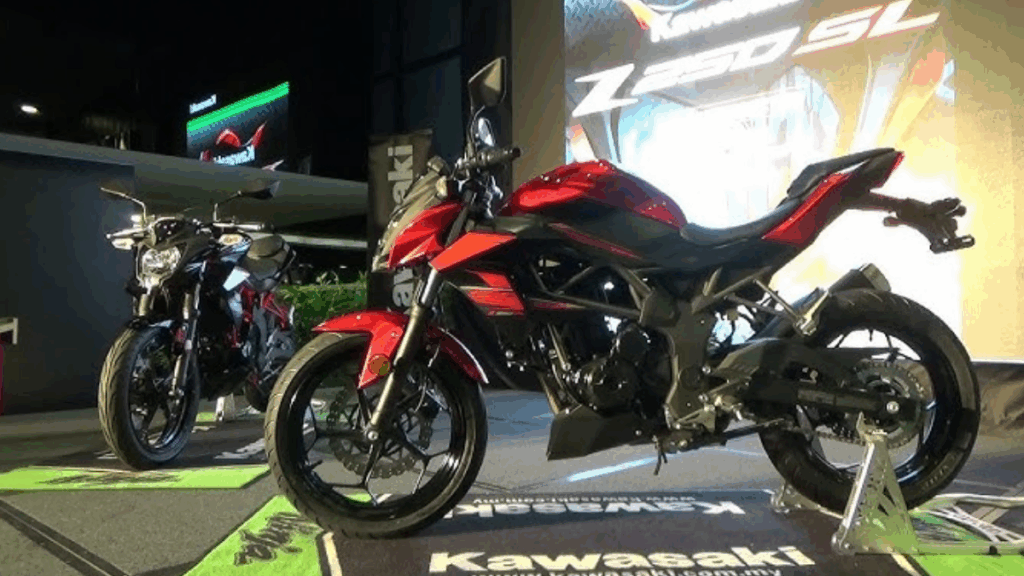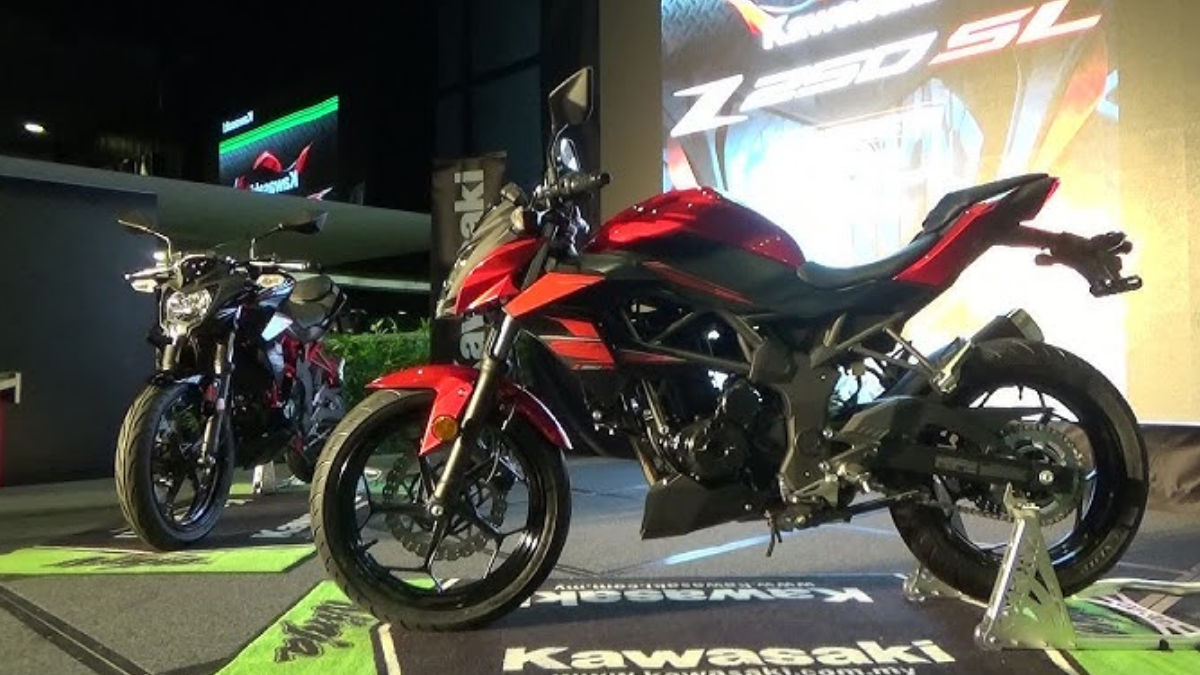Kawasaki has officially unveiled the 2026 Ninja 250 and 2026 Z250 for the Japanese market, focusing this update on fresh colour-ways and revised graphics while retaining the familiar chassis, engine, and equipment that make these 250 cc twins popular among learners and enthusiasts alike. Both motorcycles will go on sale in Japan from November 1, and while there are no mechanical changes, the visual refresh gives each bike a distinct presence for the new model year.

What’s New for 2026: Colourways & Graphics Refresh
Kawasaki’s 2026 update is squarely aimed at visual identity. Fans who appreciate model-year distinctions will notice the reworked tones and graphics placement on the headlamp cowl, fuel tank, shrouds, main frame areas, and tail sections.
- Ninja 250 now ships in two dual-tone combinations:
- Metallic Carbon Gray / Metallic Yellowish Green (a stealth base with a classic Kawasaki accent), and
- Galaxy Silver / Candy Persimmon Red (a brighter, premium look with contrast pops).
- Z250 leans into its stripped-down “Sugomi” aesthetic with one bold scheme:
- Ebony / Metallic Carbon Gray, emphasizing the muscular naked stance.
The result is a pair of 250s that, while mechanically familiar, feel refreshed and distinctly 2026 when viewed side-by-side with earlier model years.
Short Summary
Item |
Details |
|---|---|
Models Revealed |
2026 Kawasaki Ninja 250 (faired), Kawasaki Z250 (naked) |
Market & On-Sale Date |
Japan; sales begin November 1 |
What’s New |
Updated colour schemes and graphics; silhouette and mechanicals unchanged |
Ninja 250 Colours |
Metallic Carbon Gray / Metallic Yellowish Green; Galaxy Silver / Candy Persimmon Red |
Z250 Colour |
Ebony / Metallic Carbon Gray |
Engine |
248 cc, liquid-cooled, parallel-twin |
Output |
34.5 bhp, 22 Nm |
Brakes |
310 mm front disc, 220 mm rear disc |
Chassis Highlights |
17-inch wheels; tyres 110/70 (F) & 140/70 (R) |
Dimensions |
Seat height: 795 mm; Ground clearance: 145 mm; Fuel tank: 14 L |
Kerb Weight |
Z250: 164 kg; Ninja 250: 166 kg |
Official Site |
Design & Ergonomics: Sport vs. Street
Although the Ninja 250 and Z250 share their core engineering, the riding experience differs due to bodywork and ergonomics:
- Ninja 250 (faired sport):
Sculpted fairings, a windscreen, and a more front-biased stance deliver classic sportbike vibes. The fairing provides better wind management at higher speeds and gives the Ninja a sense of long-legged composure on expressways. - Z250 (naked streetfighter):
Minimal bodywork puts the engine and frame on display. The slightly more upright ergonomics suit urban commutes, frequent U-turns, and quick lane changes. The Z feels lighter on its feet at low speeds, with immediate visibility and a commanding view of traffic.
Both bikes maintain a friendly 795 mm seat height, making them approachable for a wide rider demographic, and the 145 mm ground clearance is adequate for daily duties while preserving a sporty stance.
Engine & Performance: Proven Parallel-Twin Character
Powering both machines is the 248 cc, liquid-cooled, parallel-twin that has earned a reputation for smoothness and rev-happy character:
- Max Power: 34.5 bhp
- Max Torque: 22 Nm
This output makes the Ninja 250 and Z250 well-matched to A2-style or entry-sport segments in many markets (with local licensing nuances), striking a balance between friendly learning and genuine performance for experienced riders who enjoy exploring the top end of a small twin.
Underpinnings & Braking: Balanced & Predictable
- Brakes:
- Front: 310 mm single disc (with strong initial bite and predictable progression)
- Rear: 220 mm disc (tuned for stabilization and low-speed modulation)
- Wheels & Tyres:
- 17-inch alloys front & rear
- 110/70 (front) and 140/70 (rear) tyre sizes common fitments with wide aftermarket availability, which helps riders tailor grip or longevity to their use case.
Kerb weight is kept sensible for the class 164 kg (Z250) and 166 kg (Ninja 250) which supports manageable handling in cities and nimble responses on twisty sections. The modest weight, together with a cooperative powerband, delivers the easy confidence that has kept Kawasaki’s 250 twins popular for years.
Everyday Usability: City, Campus, and Weekend Fun
Both bikes are inherently versatile:
- Daily commuting: predictable fueling, manageable size, and approachable seat height make filtering and parking easier.
- Campus & city runs: the Z250’s visibility and flickability shine; the Ninja’s fairing helps on longer rides between towns.
- Weekend rides: the Ninja 250’s wind protection encourages highway exploration; the Z250 rewards back-road agility and urban playfulness.
The 14-litre fuel tank provides reasonable range for weekly riding final range varies by riding style and conditions, but the twins’ thrifty nature is a known perk in this segment.
Ownership Lens: Who Should Buy Which?
- Choose the Ninja 250 if you love a faired sportbike look, anticipate longer highway stretches, or simply want that classic sport silhouette with a revvy parallel-twin soundtrack.
- Choose the Z250 if you prefer a clean, naked aesthetic, upright ergonomics, and city-first agility with the same fundamental performance.
Both make excellent step-up bikes from 150–200 cc singles and are also compelling second bikes for seasoned riders who want an everyday twin with low running complexity.
Frequently Asked Questions (FAQs)
1) What’s new on the 2026 Ninja 250 and Z250?
Primarily cosmetic updates: new colourways and refreshed graphics. The frame, engine, and core hardware remain unchanged.
2) When do they go on sale?
In Japan from November 1. Availability in other markets will vary by region and local Kawasaki announcements.
3) Are there any engine or suspension changes?
No mechanical revisions announced for this update. Both continue with the 248 cc parallel-twin delivering 34.5 bhp and 22 Nm.
4) How do the Ninja 250 and Z250 differ in riding feel?
The Ninja 250 offers better wind protection and a sportier posture; the Z250 feels more upright and flickable for urban use.
5) What are the braking and tyre specs?
310 mm front disc, 220 mm rear disc; 110/70 front and 140/70 rear tyres on 17-inch wheels.
6) Which one is lighter?
Z250: 164 kg; Ninja 250: 166 kg.
7) What are the seat height and ground clearance?
Seat height: 795 mm; Ground clearance: 145 mm—friendly for a wide range of riders.
8) Will these models launch in my country?
Kawasaki has announced them for Japan first. For your region, check with local Kawasaki dealers or the official website for updates.
Official Site
For detailed specifications, colours by market, and local availability, visit:
Kawasaki – Official Website
For More Information Click HERE
